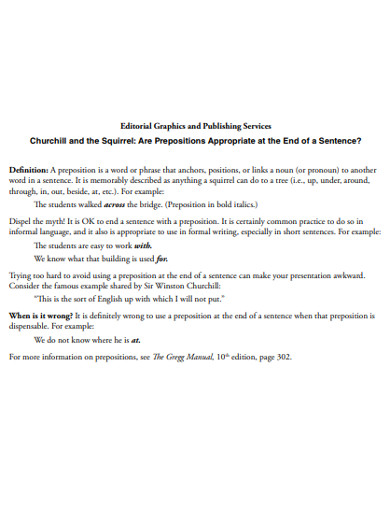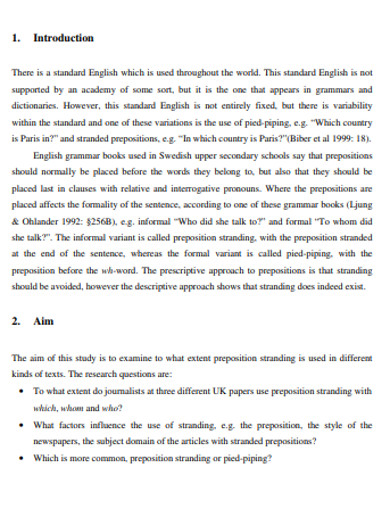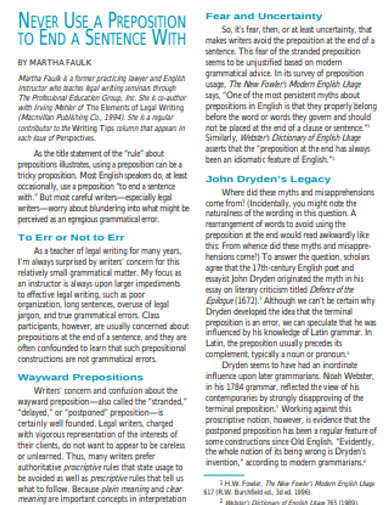10+ Preposition Sentences Examples
Most of us tend to find their composition in at fault use of prepositions. Though some writers tend to treat these as a piece of cake, for some it is a doom pit of inevitable mistakes. If you are one of those that can’t really perfect the use of prepositions then you have come on the right place. In this article, we are going to discuss the fundamentals of prepositions to improve your confidence in using them in practical scenarios. Read through to learn more.

What is a Preposition?
A preposition, like the other parts of speech, is important especially in the English grammar since it provides information to the receivers of the message such as the place, time, and date of an event and even in describing something or someone. Prepositions are usually placed before a noun or pronoun to express the relationship between another noun used in sentence construction. Prepositions are also used to introduce information to the receiver of the message. Information such as place, time, date, and even descriptive information. You may also see the Assonance and Consonance.
There are around 80 to 100 prepositions used in the English language.
Types of Prepositions
There are six types of prepositions:
1. Prepositions of Time

The prepositions of time indicate, as the terms suggest, time.
The prepositions of time include in, on, and at.
In
Sentence example using the preposition in:
1. I will have a tour in 2019.
2. I will meet you in the 3rd week of January
3. I used to hang out in the past.
On
Sentence example using the preposition on:
1. She will have a concert tour on Monday
2. She will have her birthday on the 11th of August
3. I will have a break on Independence Day.
At
Sentence example using the preposition at:
1. He will open the concert at 6:00 PM.
2. He will meet you at night.
3. I will leave at lunchtime.
2. Prepositions of Place

The aforementioned prepositions in, on, and at, can also be used to indicate places
In
Sentence example using the preposition in:
1. I live in the United States of America.
2. I hang out in a library.
3. I like to keep my pets in a room.
On
Sentence example using the preposition on:
1. She left the music box on the table.
2. She wrote a message for me on the blackboard.
3. I scribbled a note on the map.
At
Sentence example using the preposition at:
1. He will tell her to meet at the bus stop.
2. He is currently at the entrance gate.
3. I will hang out tonight at the edge of the cliff.
3. Prepositions for Direction

These prepositions, namely into, to, through, and towards
Sentences using the preposition for direction:
1. The students are heading to the ground.
2. The dog was running towards the field.
3. The participants were walking through the forest.
4. The woman was walking into the woods.
4. Prepositions of Agent

These prepositions, namely by and with, are used to show a causal relationship between the doer of the action or the noun and the action.
By
Sentence example using the preposition of agent:
1. A drink was mixed by the bartender.
2. The machine was invented by the students.
3. A lot of eggs was broken by the bagger.
5. Prepositions of Instrument, Devices or Machine

These prepositions, namely on, by, and with, are used to join the subject of the sentence or the noun to other words used in the sentence.
Sentence examples using the prepositions of an instrument, devices, or machine:
1. She arrived home by bus.
2. The canned good cannot be opened with the knife.
3. She baked the cupcakes with a crockpot.
Kinds of Prepositions
If there are types of preposition, there are also kinds of preposition:
1. Simple Preposition
The simple prepositions, the short, one-worded ones used in simple sentences.
Here are some simple prepositions:
- at
- by
- for
- from
- in
- into
- of
- off
- on
- out
- over
- till
- to
- up
- upon
- with
- under
- down
Examples of sentences with simple preposition:
- I am heading to the airport.
- He is from the neighboring town.
- She fell into the water.
- We stood by the riverbank.
- They bought the roasted pig for tomorrow’s celebration.
- Compound Preposition
- Compound prepositions are formed by adding preposition before introducing the noun, an adjective or an adverb. It is when we join nouns, pronouns, and phrases that we can form or create compound prepositions. You may also see the Kid Friendly Idioms.
Some Compound Prepositions:
- about
- across
- among
- beside
- before
- without
- inside
- outside
Examples of sentences with compound prepositions:
- The girl is sleeping beside her mother and her father
- She left before he arrived.
- He always talks about her.
- I just live across the street.
- She could not live without her dog.
2. Double Preposition
Double prepositions are two prepositions joined together to make a connection between the nouns, pronouns, and phrases in a sentence which is joined together to connect nouns, pronouns, and phases with other words in a sentence.
Here are some of the common double prepositions:
- outside of
- out of
- from behind
- up to
- next to
- because of
- according to
Examples of sentences with a compound preposition:
- A cute cat emerged from behind the post.
- The event was canceled because of the rain.
- Next to writing, my favorite hobby is drawing.
3. Participle Preposition
The participle preposition is formed when you would add -ing to the verbs but it does not act as verbs but as participle which functions similar to that of an adjective.
Here are some of the common participle preposition:
- considering
- during
- following
- including
Examples of sentences with compound prepositions:
- Considering the given situation, the teacher should have understood our side,
- He was a heroic icon during the war.
- Following the death of her parents, their son inherited the mansion.
- No one should be exempted from the incident including the class officers.
Formal Functions of Prepositions
Prepositions have three formal functions, namely:
- as an adjective modifying a noun
- as an adverb modifying verb; and,
- as a nominal when it used in conjunction and along with the verb form “to be”.
What is a Prepositional Phrase?
Learning about prepositions, you might also hear about the prepositional phrase. Prepositions are always a part of a prepositional phrase. A prepositional phrase functions either as an adjective or an adverb. Alliteration Examples and Samples For Kids
Functions of a Prepositional Phrase
As previously mentioned, there are two functions of a prepositional phrase, namely as an adjective and as an adverb.
A prepositional phrase that acts as an adjective, answers the question “which one?”.
Examples:
1. The lamp on the bedside table is broken from overheating.
Which lamp (one)? The one on the bedside table.
The prepositional phrase “on the bedside table” acts as an adjective to “the lamp”.
2. The ham sandwiches in the refrigerator are all green with mold.
Which ham sandwiches (one)? The one in the refrigerator.
The prepositional phrase “in the refrigerator” acts as an adjective to “the lamp”.
3. The letter from the principal indicated that he has been suspended.
Which letter (one)? The one from the principal.
The prepositional phrase “from the principal” acts as an adjective to “the letter”.
A prepositional phrase that acts as an adverb answers the questions “How?” “When?”, and “Where?”.
Examples:
1. In the evening, he would wash the dishes.
When does he wash the dishes? In the evening.
The prepositional phrase “in the evening” acts as an adverb of time.
2. On the topmost table, you can find the goods.
Where can you find the goods? On the topmost table.
The prepositional phrase “on the topmost table” acts as an adverb of place.
3. By standing straight, he manages to balance.
How did he manage to balance? By standing straight.
The prepositional phrase “by standing straight” acts as an adverb of manner.
How to Spot Prepositions in a Sentence
If a particular detail in a sentence talks relates or talks about time, space and logic then a preposition is certainly present. However, some prepositions act like a chameleon performing its camouflage and sometimes, it becomes so annoying that we are doubtful or can’t even identify them. If you really find it hard to recognize them, read through this article to master the following steps in distinguishing the prepositions in a sentence.
1. Know what prepositions are.
Just like people, you’ll never recognize them unless you familiarize them. In this step, you don’t have to really memorize every existing preposition available in your a thousand paged dictionary. You simply have to understand how do prepositions function in the sentence. These matters are discussed above already. For beginners, you can make a list to guide you.
2. Understand?_?_ the sentence.
In this step, imagine the message that the sentence implies. You can draw or visualize it if needed. Take the relationship between the apple/s and box/es as an example. Illustrate these following sentences:
- The apple is on the box.
- The apple is in the box.
- The apple is beside the box.
- The apple is in front of the box.
- The apple is behind the box.
- The apple is between the boxes.
- The apple is under the box.
- The apple is through the box.
- The apples are around the box.
If you are done envisioning these sentences, your picture should look like this.
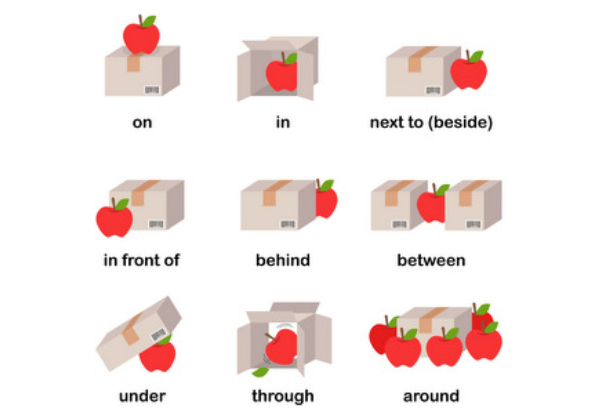
As you can see, the position of the apple/s in relation to the box/es respectively changes as you use different prepositions in the subject and manner. By acquiring a thorough understanding of the sentence, prepositions would gradually be uncovered.
3. Analyze.
Applying both steps is to analyze. Now that you already recognize what prepositions are as well as the entire picture of the sentence, it would be easier for you to ponder which of these words is the preposition.
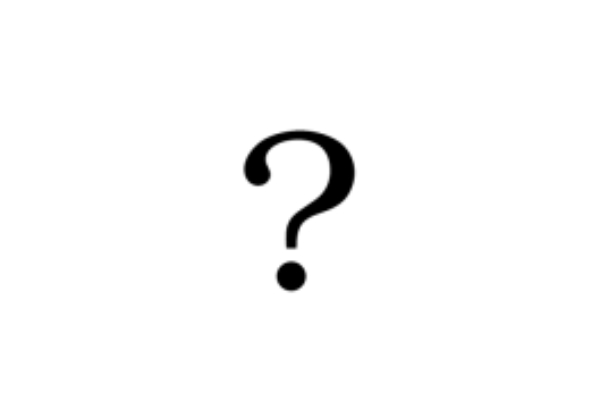
First of all, be fully aware that not all sentence has prepositions. Thus, evaluate the sentence if it draws something that correspondence to either time, position (space), means, or logic that correlates ideas first before spotting them.
Here are some sentences that have no prepositions in them:
- The flower is red.
- The basket is full.
- She speaks clearly.
- I love you.
- You make me smile.
- Let us prevent climate change.
- She brushes her teeth.
- You are a great singer.
- Practice makes perfect.
- My dictionary has new words.
On the other hand, if there is a sense of connection among objects or ideas in the sentence then recall the prepositions we discussed earlier or get the list you prepared. Now, see if a proposition exists within the sentence. Moreover, do not limit yourself to only one preposition per sentence, some of them could potentially have more or none.
Identifying the prepositions are often the path leading to the prepositional phrase. A prepositional phrase is a modifying phrase that is composed of a preposition and the object it is referring to. For example, in the sentence, I filled the baskets with apples. In this sentence, the prepositional phrase is “with apples” because it composes the phrase that holds the object and the preposition.




